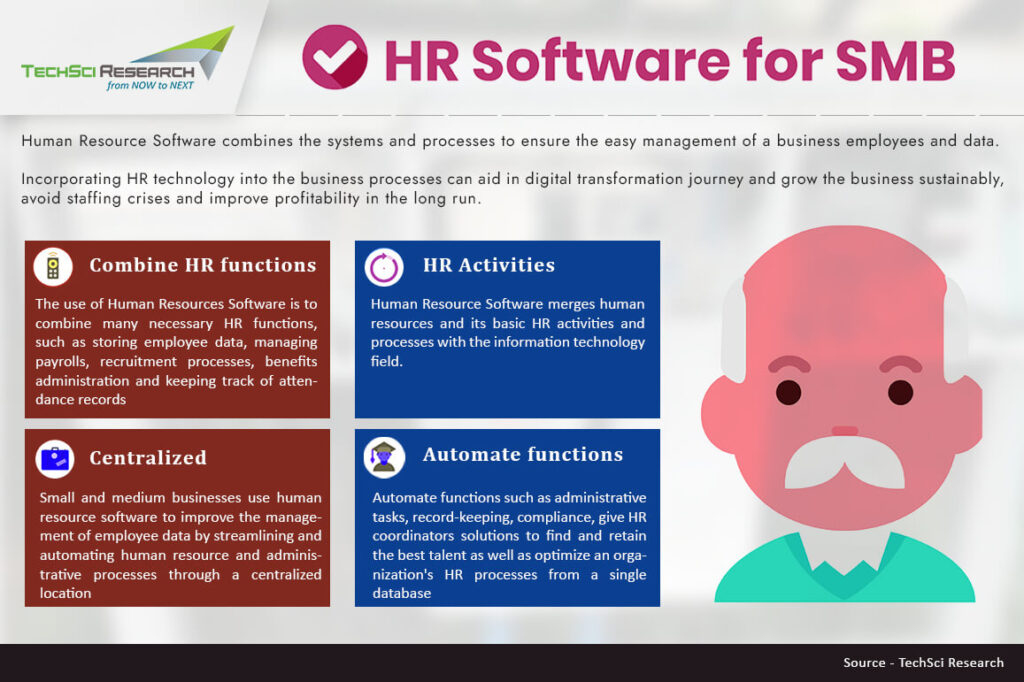Best HR Management System: Solutions for Small Business Owners
Human Resource Management (HRM) systems are integral tools for modern businesses, designed to streamline and optimize various HR processes within an organization. These systems encompass a range of software and technologies tailored to manage crucial HR functions such as recruitment, employee onboarding, performance management, training and development, payroll, and employee benefits administration.

In the fast-paced world of business, HR management systems are like the Swiss Army knives of the modern workplace. These nifty tools bring together all your HR tasks under one digital roof, making everything from hiring to payroll a breeze. Imagine having a central hub where you can effortlessly manage employee data, track performance, and handle benefits administration—all while ensuring compliance with regulations. But wait, there’s more! These systems often come with user-friendly portals that empower employees to take charge of their own info, like accessing pay slips or requesting time off. Talk about boosting engagement and transparency! Plus, with their nifty data analytics features, HR management systems offer insights into workforce trends, helping businesses make smarter decisions and plan for the future. And the best part? They seamlessly integrate with other business systems like accounting or ERP software, ensuring everything runs smoothly and your data stays squeaky clean. So, as we navigate the digital age, HR management systems aren’t just handy—they’re essential for driving success, keeping employees happy, and reaching those big-picture goals.
According to TechSci Research report “India HRMS Market Segmented By Business Application (Attendance & Leave Management System, Payroll Management System, Performance Management System, Talent Management System, Recruitment Tracking System, Others), By End User (IT & ITeS, BFSI, Healthcare, Government, Manufacturing, Retail, Others), By Region, and By Competition 2019-2029F” the India HRMS Market has valued at USD 344.45 million in 2023 and is anticipated to project robust growth in the forecast period with a CAGR of 26.16% through 2029. One of the primary drivers of this market is the rapid digital transformation across industries. Organizations are increasingly recognizing the need for streamlined HR processes to enhance efficiency and productivity.
Evolution of HR Management Systems
Similar to everything around us, the Human Resource Management Systems (HRMS) has also evolved significantly over time and for the better, accordingly with the changing needs of the organization and workforce. Let us delve further into how this evolution has taken place:
- Administrative HRM
Rooted in traditional practices, it was the earliest form of HR Management systems where HR was primarily responsible for compliance with the laws and for record keeping. Administrative HRM ensures the smooth functioning of HR processes, including recruitment, hiring, and termination procedures, while also overseeing employee documentation and policy adherence.
- Behavioral HRM
During the era of 1950s and 1960s, Human Resource Management (HRM) underwent a transformative shift, shining a spotlight on the behavioral dynamics of employee management. This new approach prioritized understanding and nurturing employee motivation, effective communication channels, and the cultivation of strong leadership skills. As a result, this period witnessed the rise of innovative practices such as performance management systems, comprehensive employee training schemes, and dynamic team-building endeavors.
- Strategic HRM
This HRM system emerged in the 1980s and 1990s due to the response towards changing business environment. It centers on harmonizing HR tactics with business goals and aspirations. It underscores the cultivation of a high-performing work environment, the progression of human behavior, effective talent management, and workforce planning.
- International HRM
As the world becomes more interconnected and multinational companies expand their reach, Human Resource Management (HRM) has adapted to embrace a global perspective. International HR management systems now concentrates on effectively overseeing employees hailing from diverse cultures, operating in various countries, and navigating distinct legal frameworks. This evolution entails crafting global HR policies and procedures that strike a delicate balance between standardization and customization to suit local contexts. This specific approach ensured that organizations can successfully navigate the complexities of operating on a global scale while fostering inclusivity and respect for cultural diversity among their workforce.
- Digital HRM
In recent years, the advancement of HRM systems have transformed how big and small businesses improve and manage their employee and business operations. This transformation, known as Digital HRM, encompasses a wide array of tools and platforms, including HR information systems, online recruitment platforms, e-learning modules, social media channels, and sophisticated data analytics software. By leveraging these digital advancements, organizations can not only streamline their HR operations but also make more informed decisions and enhance the overall employee experience. From automating routine tasks to unlocking valuable insights from data, Digital HRM is reshaping the way HR functions operate in the modern era, paving the way for greater efficiency and effectiveness.
Features and Benefits of HR Management Systems: The Most Popular Ones
In today’s fast-paced business world, having some level of HR automation is vital for companies aiming to stay competitive. Boosting employee productivity is a key factor in driving business growth. By automating repetitive and time-consuming tasks, HR professionals can free up valuable time to focus on strategic initiatives using HR management systems (HRMS). This isn’t just a solution for large corporations; it’s equally crucial for small and medium-sized enterprises with limited HR resources. Embracing HR automation levels the playing field, empowering businesses of all sizes to enhance efficiency and effectiveness in managing their workforce.
Here is a set of 5 top-rated functionalities of HRM softwares:
Financial Management
Imagine having to manually manage payments for dozens of employees simultaneously. Thankfully, you don’t have to, as HR software can revolutionize this crucial task, ensuring employees receive their rightful compensation promptly and accurately, giving you peace of mind. With various modules catering to base salary administration, bonus schemes, commissions, and stock and long-term incentives, managing financial aspects becomes a breeze. Even for small organizations, an HRM system streamlines financial planning, empowering you to handle finances with greater efficiency and precision.
Employee Information Management
Employee Information Management is a cornerstone feature every HR software should offer. It should provide a complete and detailed directory of employees, encompassing their personal details, employment history, salary records, banking and tax information, insurance details, leave requests, and any other pertinent information relevant to your company. Having all this data organized and accessible in one place simplifies HR processes, enhances efficiency, and ensures accurate record-keeping, facilitating smoother operations and better employee management.
Recruitment and Hiring
A top-notch HRMS serves as the ultimate ally for your HR team, handling all aspects concerning personnel within the organization. From kickstarting the employee journey with the recruitment process, HR software offers seamless automation to streamline hiring procedures. For instance, you can effortlessly broadcast job openings across multiple platforms and websites, with the system even crafting job descriptions automatically. As applications flood in, the system efficiently sorts through candidates, accepting or rejecting them based on their suitability for the role. This ensures a smooth and efficient hiring process, allowing your team to focus on finding the perfect fit for your organization.
Time and Attendance Management
Human Resource Management systems offer features tailored to streamline the management of employee schedules and attendance, ensuring your company stays compliant with staffing requirements. With the right HR software in place, you can efficiently schedule employees across different departments, locations, and projects. This ensures clarity for you and your colleagues regarding who is present at work on any given day and who is on leave. By leveraging these functionalities, you can maintain optimal staffing levels while enhancing transparency and organization within your workforce.
Talent Management
Here’s another essential feature you’ll want to consider for your HRM system: talent management. This tool assists in assessing employees’ performance and, once they’re onboarded, provides valuable insights into their productivity, customer satisfaction levels, and beyond. Some systems go the extra mile by offering automated feedback or supporting HR teams with in-depth analyses generated by the software. Through your best HR management systems, with talent management capabilities at your fingertips, you can effectively nurture and leverage the potential of your workforce, driving both individual and organizational success.
HRM Systems: Its Contrasting Requirements for Small Vs Large Businesses
In the dynamic world of human resource management (HRM), whether you’re in a bustling startup or an already well-established company, the ultimate objectives remain the same. However, the journey to achieving these goals and the arsenal of resources at your disposal can vary significantly between smaller enterprises and larger organizations. Let’s delve into this intriguing contrast, exploring how the paths HRM departments choose and the tools they wield shape their approaches to common objectives.
- Resources: Both Physical and Human Aspect
Being in the arsenal of managing people at work, no matter whether it’s a big company or an emerging startup, the core goals remain similar. However, the way both the aspects are approached can be different depending on the size of the business. In smaller companies, the HR team has to manage fewer resources, and are responsible for everything from finding new talent to making sure the employees get paid on time. However, in bigger companies, the entire HR department has more tools and people to work with. Their use with dedicated software helps the HR department makes sure everything runs smoothly.
- Size Of The Company
In larger companies, it’s common to find a dedicated Human Resource Management (HRM) department staffed with multiple HR executives or managers. Conversely, small and medium-sized enterprises (SMEs) often operate with fewer HR resources, sometimes relying solely on one HR executive or manager, or improvising with existing administrative staff or other personnel such as Operations Managers or Assistant Directors. This discrepancy in HR resources can present challenges for SMEs, as they may have fewer individuals to shoulder the various responsibilities associated with HRM. Additionally, limited staffing can translate to less collective experience, potentially leading to a steeper learning curve and a greater likelihood of encountering obstacles along the way. Consequently, SMEs may find it more challenging to execute HR functions effectively, innovate in their approaches, and consistently meet the needs and expectations of their employees.
- Responsibilities
In the realm of small businesses, the team is often small, and each member wears multiple hats to keep things running smoothly. You might find yourself not only handling HR duties but also serving as the assistant to the managing director or even taking on accounting tasks. In these smaller setups, the HR unit, which may consist of just one person – a jack-of-all-trades business management expert – often finds itself reacting to immediate needs, rather than proactively strategizing. Now, let’s shift to large organizations, where HR gets the royal treatment with its own dedicated department. Here, entire teams handle everything from payroll to policymaking, leaving no room for one person to juggle it all. With specialists in each area, employees can breathe easy knowing there’s ample support available. Working in such a setup means you’re never alone in tackling challenges; there’s always someone to lend a helping hand. So, while small businesses may offer a sense of versatility, large corporations provide the luxury of specialized support through their best HR management systems.
- Recruitment
Finding the right people to join the company’s team is an entirely different game, especially for small businesses. Unlike their large corporation counterparts with hefty budgets for elaborate hiring processes, small companies often have to make do with simpler methods. Think scouring social media, making reference calls, and wrapping things up with a final interview. Tight budgets and limited time mean they’ve got to get creative with their recruitment efforts. Though the recruitment process may seem simple due to small scale of the company, it is filled with potential challenges and its own limitations that arise due to the lack of resources and man-power.
HR Problems in Small and Medium Businesses: The Very Specific Ones
- SME HR departments often struggle to implement effective performance management strategies and provide opportunities for employee development due to limited resources and time constraints. This can hinder employee growth and engagement within the organization.
- In small businesses, employees may be assigned HR responsibilities without proper training or expertise in HR practices. This lack of specialized knowledge can lead to inefficiencies and compliance risks in HR operations.
- SMEs typically have smaller budgets and fewer HR personnel compared to larger organizations, making it challenging to invest in advanced HR technologies, training programs, or dedicated HR staff. This can result in manual and time-consuming HR processes and difficulties in managing various HR functions effectively.
- Retaining top talent is a significant concern for SMEs, as they may struggle to offer competitive salaries, benefits, and career advancement opportunities compared to larger companies. This can lead to higher turnover rates and talent shortages, impacting business continuity and growth.
- SMEs often face challenges in attracting and hiring qualified candidates due to limited visibility and resources for recruitment efforts. Without robust recruitment strategies and employer branding initiatives, SMEs may struggle to compete with larger organizations for top talent.
- Managing workplace conflicts and grievances effectively is crucial for maintaining a positive work environment and productivity. However, SMEs may lack formal HR policies, procedures, or trained personnel to address conflicts promptly and impartially, leading to unresolved disputes and morale issues.
- Staying compliant with ever-changing employment laws and regulations can be daunting for SMEs, especially without dedicated legal expertise or resources. Non-compliance can result in legal liabilities, fines, and reputational damage for the business.
For small businesses, thankfully, today, there exists a plethora of modern HR management systems for small businesses to help them maintain compliance, improve employee management, and focus on growth.
- BambooHR: Its customizable dashboards and reporting tools empower HR professionals to gain valuable insights into their workforce, facilitating data-driven decision-making. Moreover, BambooHR’s cloud-based platform ensures accessibility from anywhere, anytime, making it ideal for remote or distributed teams.
- Paycor: It stands as a dynamic HR and payroll software solution crafted to streamline workforce management for businesses. Through its user-friendly interface and robust features, Paycor simplifies crucial HR processes like payroll processing, time and attendance tracking, benefits administration, and talent management.
- Trinet: Trinet is a comprehensive HR outsourcing solution that caters to the diverse needs of businesses. Offering a wide range of services, Trinet simplifies HR administration, payroll processing, benefits management, and compliance, allowing businesses to focus on their core objectives. The software is best known for its robust mobile app.
Other popular HRMS for small businesses are Deel, Rippling, Freshteam, Eddy, ZenHR, Breezy HR, among others.
The “HOW” of Strategizing the Adoption of HRMS for SMEs To Their Benefit
- Assessing Needs and Objectives
Small businesses are always suggested to proceed with their HRMS decision by identifying their specific HR needs and objectives. This involves evaluating current HR processes, identifying pain points, and determining desired outcomes. It may also include limited financial resources, lack of technical expertise, and concerns over data privacy and security. Understanding these factors will help SMEs select a system that aligns with their goals and requirements. For example, if tracking employees’ attendance and payroll management is starting to become a hassle for the HR, then employing an HRM system which is dedicated to employee management and attendance would be the best approach.
- Involving Stakeholders
Small and medium-sized enterprises (SMEs) stand to benefit greatly from involving key stakeholders, such as HR personnel, management, and employees, in the decision-making process when selecting an HR management system. By gathering input from a diverse range of perspectives, including those who will directly interact with the system, SMEs can ensure that the chosen solution aligns with the needs and preferences of all users. Moreover, involving stakeholders from the outset can foster a sense of ownership and buy-in, increasing the likelihood of successful implementation and adoption of the new HR management system.
- Research is Foremost
For small and medium-sized enterprises (SMEs), conducting thorough research into the array of HR management systems available in the market is crucial to finding the ideal solution that aligns with their specific needs and budgetary constraints. This process entails delving into various aspects such as examining features, functionalities, pricing plans, customer reviews, and the reputation of vendors. Moreover, it’s imperative for SMEs to prioritize selecting a system that not only meets their current requirements but also offers scalability and flexibility to adapt to future growth and evolving business needs. By investing time and effort in comprehensive research, SMEs can make informed decisions that lay the foundation for effective HR management practices and sustained business success.
- Integration and Customization Room
SMEs should customize the HR management system to align with their unique business processes and workflows. This may involve configuring settings, creating custom fields, and tailoring reports to meet specific requirements. Additionally, integrating the HR management system with other existing business systems, such as accounting or payroll software, can streamline processes and enhance data accuracy.
- Pilot Testing
One of the critical steps in employing an HRM system involves conducting pilot testing before fully implementing the system across the organization. For SMEs, it’s essential to select a small group of users to participate in this initial testing phase. By doing so, SMEs can facilitate real-world evaluation of the system’s functionality and usability, allowing users to provide valuable feedback and identify any potential issues or areas for improvement. This pilot testing phase serves as a valuable opportunity to fine-tune the system and address any concerns before rolling it out to the entire organization. Additionally, involving users in the testing process fosters a sense of ownership and investment in the new system, increasing the likelihood of successful adoption and integration into daily operations.
According to TechSci Research report “Human Resource Management Software Market – Global Industry Size, Share, Trends, Opportunity, and Forecast, 2018-2028, Segmented By Deployment (Cloud, On-Premises), By Organization Size (Small & Medium Enterprise, Large Enterprise), By Type (Workplace Management, Talent Management, Sourcing & Recruitment, Applicant Tracking System), By End User (IT & Telecom, BFSI, Manufacturing, Retail, Public Sector, Healthcare, Transportation & Logistics, Others), By Region, Competition Forecast” The projected market size for the global human resource management software (HRMS) market is anticipated to reach USD 20.54 billion by the conclusion of 2022, exhibiting a compound annual growth rate (CAGR) of 11.27% over the forecast period. The global HRMS market represents a rapidly growing and dynamic sector within the broader realm of enterprise software solutions. HRMS encompasses a comprehensive suite of software tools and platforms that are meticulously designed to optimize and streamline various human resource functions. These functions range from recruitment and onboarding to performance management, payroll processing, employee engagement, and more.
AI and ML in HRM Systems: Unlocking the Potential
In today’s rapidly evolving world of human resource management, Artificial Intelligence (AI) and Machine Learning (ML) are making waves, paving the way for a more efficient, personalized, and strategically driven approach. At the core of this revolution are the remarkable capabilities of AI and ML algorithms to sift through massive amounts of data, uncovering patterns and valuable insights that power various HR functions. For example, one of the most significant impacts of AI and ML in HR management systems is in talent acquisition. These technologies automate and optimize the recruitment process, from candidate sourcing to selection, by leveraging predictive analytics and natural language processing (NLP) algorithms. AI-driven applicant tracking systems (ATS) scan resumes, identify relevant keywords, and rank candidates based on their qualifications and fit for the role. ML algorithms analyze historical hiring data to predict candidate success and optimize hiring strategies, reducing time-to-fill and improving the quality of hires.
One Candidates are Onboarded:
AI and ML continue to play a vital role in employee onboarding and engagement. Today, virtual assistants (powered by AI) have started to play an important role through the onboarding process, providing them with relevant information about company policies, procedures, and culture. Additionally, AI-driven sentiment analysis tools monitor employee feedback and engagement levels, enabling HR teams to identify trends, address concerns, and improve overall employee satisfaction.
In the Realm of Performance Management:
AI and ML enable organizations to leverage data-driven insights to optimize employee performance and development. These technologies analyze various metrics, such as productivity, attendance, and goal attainment, to assess individual and team performance in real-time. ML algorithms identify patterns and trends in employee performance data, enabling managers to provide timely feedback, coaching, and recognition. AI-powered performance management systems also facilitate goal setting, performance reviews, and career development planning, empowering employees to reach their full potential.
Predictive analytics powered by AI and ML provide HR professionals with valuable insights into workforce trends, enabling them to make informed decisions and develop proactive strategies. These technologies analyze historical HR data, such as turnover rates, retention risks, and workforce demographics, to forecast future trends and identify potential risks. Predictive analytics help HR teams anticipate talent shortages, succession planning needs, and employee turnover risks, enabling them to develop targeted retention strategies and talent acquisition plans. Additionally, AI-driven workforce planning tools optimize workforce allocation, budgeting, and resource allocation, ensuring alignment with organizational goals and objectives.
Compliance Monitoring Is No Hassle:
Compliance and risk management are also bolstered by AI and ML capabilities in HR management systems. These technologies automate compliance monitoring, auditing, and reporting processes, reducing the risk of errors and non-compliance with labor laws and regulations. AI-driven compliance tools analyze HR data to identify potential risks, violations, and anomalies, enabling HR teams to take proactive measures to mitigate risks and ensure adherence to legal requirements. ML algorithms also help organizations stay updated on changing regulations, anticipate compliance challenges, and develop effective risk management strategies.
Summing Up
In today’s competitive landscape, small businesses are increasingly recognizing the pivotal role that Human Resource Management Systems (HRMS) equipped with Artificial Intelligence (AI) and Machine Learning (ML) can play in driving success. These innovative technologies are reshaping how small businesses approach HR functions, offering newfound efficiencies, personalized experiences, and strategic insights that were once reserved for larger enterprises. At the heart of this transformation lies the ability of AI and ML algorithms to analyze vast amounts of data swiftly and accurately. For small businesses with limited resources, this capability is particularly valuable, as it enables them to make informed decisions without the need for extensive manpower or expertise.
Furthermore, AI and ML enable small businesses to stay compliant with regulations and mitigate risks more effectively. These technologies can analyze vast amounts of data to identify potential compliance issues and flag them for HR professionals to address promptly. By automating routine tasks and processes, AI and ML reduce the likelihood of errors and ensure that small businesses remain compliant with labor laws and regulations.
Therefore, in conclusion, HRMS powered by AI and ML offer small businesses a competitive edge by providing them with the tools and insights needed to effectively manage their human capital. From talent acquisition to employee engagement and compliance, these technologies enable small businesses to operate more efficiently, make data-driven decisions, and foster a culture of growth and innovation. As AI and ML continue to evolve and become better, their role in HRMS for small businesses will only become more pronounced, hence, driving continued success and prosperity in the years to come.



